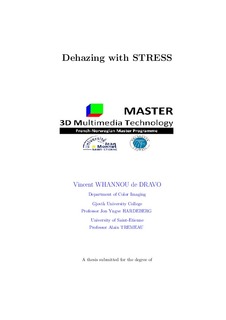| dc.description.abstract | There exist today plenty of algorithms and many papers about dehazing
or defogging, that is enhancing images taken in hazy or foggy
conditions. To our knowledge none of them has got a signifcant result
for dense and non-dense haze image at the same time. In this master
thesis, we will propose an algorithm that are able to dehaze both dense
and non-dense hazy images. Our hope comes from the fact that we
observe in dense hazy images, the Spatio-Temporal Retinex-inspired
with Stochastic Sampling (STRESS) framework (Kolas et al., JIST,
55(4), 2011) gives a more visually pleasing result when we compare it
with the DCP algorithm (He et al., CVPR, 2009) for the same input.
Our hypothesis is that STRESS uses one or more of its principles to
enhance effciently dense hazy images. In this work, we will show how
we find out this hypothesis and also justify it.
For the purpose of our experiment, we define a new database where
images are separeted according to their degree of haziness (fuzzy,
medium and very fuzzy). The dehazing algorithms that we consider
are typically (Fattal, Proc. ACM SIGGRAPH, 27(3), 2008), (Fattal,
Proc. ACM SIGGRAPH, 34(1), 2014), To evaluate the quality of these
dehazed images, we use some metrics and a psychophysical approach.
From this experiment on the previous works, we show their relationships
with STRESS and finally the performance of the new algorithm
which is the combination with some of them with STRESS idea is
showed as well. Basically our algorithm assesses the hidden free-haze
layer by assuming that there are three patterns almost in outdoor hazy
images namely: sky region (or regions which have the same behaviour,
like snow), far objects and near objects. The experiment shows also
that our algorithm based on the two-scale STRESS approach, edge
detection and Hidden Markov Model has often more visibility level
than most of state-of-the-art algorithm when using the metrics de-
fined in (Hautiere et al., Image Analysis & Stereology Journal, 27(2),
2008). | nb_NO |
